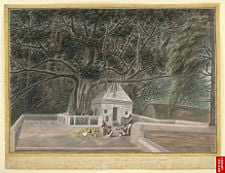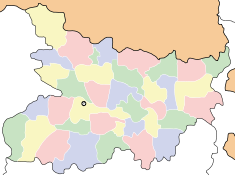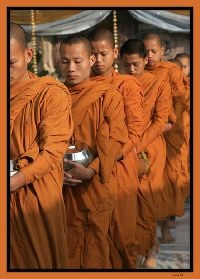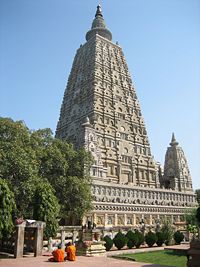Difference between revisions of "Bodh Gaya" - New World Encyclopedia
Mary Anglin (talk | contribs) m |
Mary Anglin (talk | contribs) |
||
| Line 28: | Line 28: | ||
| − | + | The Mahabodhi temple stands tall in the very heart of Bodh Gaya. In | |
| + | fact the town has been built around it. | ||
| Line 46: | Line 47: | ||
Bodh Gaya's temple and monasteries fell into ruin when state support ceased under the rule of the Islamic Sultanate of Delhi. During this time Buddhist Siddhas, and Shaivite Nath Siddha ascetics continued practice in the village and Shaivite ascetics established a permanent monastery. Eventually the Abott became the local ruler, which lasted until India's independence in 1947. | Bodh Gaya's temple and monasteries fell into ruin when state support ceased under the rule of the Islamic Sultanate of Delhi. During this time Buddhist Siddhas, and Shaivite Nath Siddha ascetics continued practice in the village and Shaivite ascetics established a permanent monastery. Eventually the Abott became the local ruler, which lasted until India's independence in 1947. | ||
| − | The city's center, the Mahabodhi Temple, was in serious disrepair by the 1880s, when a Burmese mission to repair the temple began. At the same time the British annexed [[Burma]], spurring the Britain into supportive action. At this point the [[Archaeological | + | The city's center, the Mahabodhi Temple, was in serious disrepair by the 1880s, when a Burmese mission to repair the temple began. At the same time the British annexed [[Burma]], spurring the Britain into supportive action. At this point the [[British Archaeological Society]] took over the rebuilding of the temple under the direction of [[Alexander Cunningham]]. The present form of the temple complex is that of this 19th century reconstruction. <ref name=PF/> Also during this time a [[Ceylon]]ese Buddhist leader, [[Anagarika Dharmapala]], began a long campaign to return responsibility for the temple to Buddhist management. |
Following India's independence in 1947 management of the Mahabodhi Temple became increasingly controversial. It was eventually taken out of the hands of the Hindu Abotts and put into the hands of The Temple Management Committee, formed specifically for this purpose. The committee consisted of both Hindus and Buddhists, with a required majority of Hindus. | Following India's independence in 1947 management of the Mahabodhi Temple became increasingly controversial. It was eventually taken out of the hands of the Hindu Abotts and put into the hands of The Temple Management Committee, formed specifically for this purpose. The committee consisted of both Hindus and Buddhists, with a required majority of Hindus. | ||
Revision as of 22:14, 7 July 2008
| Bodh Gaya Bihar • India | |
| Coordinates: | |
| Time zone | IST (UTC+5:30) |
| District(s) | Gaya |
| Population | 30,883 (2001) |
Coordinates: The village of Bodh Gaya is in the Gaya district in the Indian state of Bihar. It is situated west of the Phalgu River, a tributary of the Ganges River. India's 2001 census reported Bodh Gaya's population as 30,883. Historically, it was known as the Bodhimanda (ground around the Bodhi-tree), and was home to a large monastic settlement. The main monastery of Bodh Gaya is the Mahabodhi Temple, which was designated a UNESCO World Heritage Site in 2002, based upon the criteria that it has "outstanding universal importance as it is one of the most revered and sanctified places in the world".
The Mahabodhi temple stands tall in the very heart of Bodh Gaya. In
fact the town has been built around it.
Bodh Gaya is considered by Buddhists as one of the world's most holy cities. Gautama Buddha is reported to have attained Enlightenment there. Buddhists hold that Bodh Gaya is one of the four holy pilgrimage sites that the devout must visit as part of their religious development. It is said that as the Buddha lay dying, he gave instruction that lay people should make pilgrimages to four specific places related to his life: the place of his birth (Lumbini, Nepal), the place of his enlightenment, the place of his first teaching (Sarnath, near Varanasi), and the place of his passage from this life (Kushinagar). Some believe that those who worship at the shrines erected at these 4 holy places will be reborn as gods.
History
Archaeological excavations provide evidence of human habitation in Bodh Gaya as early as 1100 B.C.E. There is evidence of settled agriculture, hunting and fishing, as well as copper smelting. Homes were constructed of reed and bamboo or wattle and daub. Remnants of arrow heads, fish hooks, stone implements, and pottery have been unearthed. Cereals and rice were being cultivated, as is evidenced by rice husk impressions in the Black and Red ware pottery. [1] The introduction of iron implements and coinage occurred between 600-200 B.C.E. Also arising during this time were new techniques in the creation of pottery, resulting in mirror-like light ceramic known as Northern Black Polished Pottery.
The Iron Age was also the era of Gautama Buddha's life, especially significant to Bodh Gaya as the location of his enlightenment. According to Buddhist and Brahminical texts both Bodh Gaya and Gaya were beginning to host religious pilgrims by the end of this period.

Over the next several hundred years the village became a major Buddhist pilgrimage location. Emperor Ashoka visited Bodh Gaya approximately 250 years after Buddha's time, erecting a monument in the form of a shrine under the Bodhi Tree under which, according to tradition, the Buddha attained enlightenment. Ashoka is credited with being the creator of the well-known Mahabodhi Temple.
Buddhism, and Bodh Gaya with it, flourished. The city was at the heart of a Buddhist civilization for centuries, with life being centered around the Mahabodhi Temple and other monasteries and monuments. At least four additional shrines were added to the main temple by the 13th century, at which time the city was conquered by Turkish armies.
Bodh Gaya's temple and monasteries fell into ruin when state support ceased under the rule of the Islamic Sultanate of Delhi. During this time Buddhist Siddhas, and Shaivite Nath Siddha ascetics continued practice in the village and Shaivite ascetics established a permanent monastery. Eventually the Abott became the local ruler, which lasted until India's independence in 1947.
The city's center, the Mahabodhi Temple, was in serious disrepair by the 1880s, when a Burmese mission to repair the temple began. At the same time the British annexed Burma, spurring the Britain into supportive action. At this point the British Archaeological Society took over the rebuilding of the temple under the direction of Alexander Cunningham. The present form of the temple complex is that of this 19th century reconstruction. [3] Also during this time a Ceylonese Buddhist leader, Anagarika Dharmapala, began a long campaign to return responsibility for the temple to Buddhist management.
Following India's independence in 1947 management of the Mahabodhi Temple became increasingly controversial. It was eventually taken out of the hands of the Hindu Abotts and put into the hands of The Temple Management Committee, formed specifically for this purpose. The committee consisted of both Hindus and Buddhists, with a required majority of Hindus.
In the 1990s followers of Bhimrao Ramji Ambedkar campaigned for exclusive Buddhist control of the temple, which was granted.
Name
In the 6th century B.C.E. Bodh Gaya was known as Uruvilva or Uruvela. Within two hundred years that name fell into dis-use and the city has had several names since that time, all influenced by the historic event of Buddha's enlightenment. These names include:
- Sambodhi (meaning "Complete Enlightenment"), in use by the 3rd century B.C.E., the time of Emperor Ashoka,
- Bodhimanda (meaning "the area around the Bodhi Tree"),
- Vajrasana (meaning the "Diamond Throne"), and
- Mahabodhi (meaning "Great Enlightenment"), in use as early as the 7th century C.E..
By 1861 when the temple was excavated and restored, it was popularly called Buddha-Gaya or Bodh Gaya.
Geography
Bodh Gaya City is located in the Gaya district of the Indian state of Bihar, 6 miles (10 km) south of the city of Gaya. It is located on the western banks of the Phalgu River (or Falgu River, also known as Niranjana River), one of the tributaries of the river Ganges.
Bodh Gaya Block covers an area of over 96 square miles (249 sq km) and contains 139 villages. The total population of the block is 91,882. [3] The population of the Bodh Gaya city proper was 30,883 according to the 2001 census.
Bihar lies near the junction of the Gangetic Plain and the Choṭa Nāgpur plateau and is notoriously hot (highs of 35-40 °C; 95-105 °F) in the summer months of April to mid-June. Monsoon season takes place in June, July, August, and September. The weather is quite pleasant during the periods of October & November and February & March. It is mildly cold in the winter months, which consist of December and January (lows of 5 to 10 °C; 41 to 50 °F).
Economy
The population of Bodh Gaya Block is predominately rural, with the majority of people participating in agriculture as a primary occupation. Crops in the surrounding region include grains, oilseeds, and sugarcane, aided through irrigation from 4 nearby rivers - the Son, Pūnpūn, and Morhar in addition to the Phalgu.
Most of the money that comes into the area, however, comes from the tourism trade. Bodh Gaya was designated as one of the four official pilgrimage sites by Gautama Buddha. For this reason many devout Buddhists travel to the city as part of their religious development. The city plays host not only to the religiously devout, but also to those who travel to the city for its historic and cultural significance.
Poverty
India is seen as a rapidly developing country with a high growth rate. While the nation's poverty rate has been reduced significantly, 17.6 percent of Indians still live below the national poverty line. Since the early 1950s, successive governments have implemented various schemes to alleviate poverty, which have met with partial success. Much of the development has taken place in the larger metropolitan areas, and has not stretched significantly into the rural areas.
The state of Bihar is one of the poorest and most violent regions of the nation. In spite of Bodh Gaya's illustrious past as the place of Buddha's enlightenment, many of the city's people today suffer tremendous hardship. Much attention is given to the city due to the potential of further development as a tourist destination and the profits to be made. There are also organizations working in the city with more altruistic purposes, such as providing education and improving literacy, helping citizens to find employment, medical care, housing and utilities.
Pilgrimage sites
In 1953, Bodh Gaya began to experience development as an international pilgrimage destination. Buddhist temples and monasteries in the city have since been built by the people of Bhutan, China, Japan, Myanmar, Nepal, Sikkim, Sri Lanka, Thailand, Tibet and Vietnam in a wide area around the temple. These buildings reflect the architectural style and both exterior and interior decoration of their respective countries. The statue of Buddha in the Chinese Temple is 200 years old and was brought from China. Japan's Nippon Temple is shaped like a pagoda. The Myanmar (Burmese) Temple is also pagoda-shaped and is reminiscent of Pagan. The Thai Temple has a typical sloping, curved roof covered with golden tiles. Inside, the temple holds a massive and spectacular bronze statue of Buddha. In a 100 year old garden beside the Thai temple is an 82 foot (25 m) recently erected statue of the Buddha. There are two Tibetan Buddhist temples.
Mahabodhi temple
The Mahabodhi Complex contains the Mahabodhi Temple with the diamond throne (Vajrasana) and the holy Bodhi tree. Tradition has it that the diamond throne marks the exact spot on which the Buddha sat as he attained enlightenment. The tree which is now at the site was a sapling of the Sri Maha Bodhi tree in Sri Lanka, itself grown from a sapling of the original Bodhi tree.
The original temple consisted of an elongated spire crowned by a miniature stupa and a chhatravali on a platform. A double flight of steps led up to the platform and the upper sanctum. The mouldings on the spire contained images of Buddha in niches. Some historians believe that the temple was constructed or renovated in the 1st century during the Kushan period. With the decline of Buddhism in India, the temple was abandoned and forgotten, buried under layers of soil and sand.
The temple was later restored by Sir Alexander Cunningham as part of his work for the British Archaeological Society in the late 19th century. In 1883, Cunningham, along with J. D. Beglar and Dr. Rajendralal Miitra, painstakingly excavated the site. Extensive renovation work was carried out to restore Bodh Gaya to its former glory. Some of its intricately carved railings are believed to be from the original temple, while others are reproductions. This temple is also sacred to the Hindus, as they believe the Lord Buddha is the ninth incarnation of Lord Vishnu.
Bodhi tree
This 80 foot tall tree is located behind the Temple. It is not the original tree under which the Buddha attained enlightenment, however it is a descendant of that tree. A sapling of the original tree was carried by Emperor Asoka's daughter (Sanghamitta) to Sri Lanka. A cutting from that tree was planted in Bodh Gaya when the original tree died. Under the tree is a red sandstone slab known as the Vajrasana, the diamond throne, that Buddha sat upon and attained enlightenment.
Additional sites
- Chankaramana - the sacred spot of Buddha's meditative perambulations during the third week after enlightenment. It is believed that wherever the Buddha put his feet lotus flowers sprang up.
- Arimeshlochana - it is said that the Buddha spent 7 days in this location, gazing toward the great Mahabodhi Tree in gratitude, without blinking his eyes.
- Ratnagar - Buddha is believed to have spent one week here, during which time rays of five colors emitted from his body.
- Mohanta's Monastery - this is a Shaivite monastery, located next to the Mahabodhi Temple. Adi Sankaracharya spent days here in a heated debate with Buddhist philosophers.
- Tibetan Mahayana Monastery - inside is a large Dharma Chakra, or wheel of law. It is believed that you will be freed of sin if you spin this wheel three times in succession from left to right.
- Lilanja River (Niranjana River in Buddha's time) - Buddha bathed here following his enlightenment. It is approximately 250m east of the temple. Prince Siddhartha crossed this river to reach the Bodhi tree.
- BiMT.jpg
Buddha in the Mahabodhi Temple.
See Also
- Mahabodhi Temple
- Bodhi Tree (Bo tree)
- Buddha
- Buddhism
Notes
- ↑ Ansari, pp 44-51.
- ↑ British Library. Asia, Pacific and Africa Collections Retrieved July 7, 2008.
- ↑ 3.0 3.1 Peter G. Friedlander. June 26, 2002. Background Bodhgaya News. Retrieved July 3, 2008.
ReferencesISBN links support NWE through referral fees
- Ansari, A.Q. 1990. Archaeological Remains of Bodh Gaya. Delhi. Ramanand Vidya Bhawan.
- Asher, Frederick M. 2008. Bodh Gaya. Monumental legacy. New Delhi: Oxford University Press. ISBN 9780195693140
- Aitken, Molly Emma. 1995. Meeting the Buddha on pilgrimage in Buddhist India. New York: Riverhead Books. ISBN 9781573225069
- Banerjee, Naresh, and Naresh Banerjee. 2000. Gaya and Bodh Gaya a profile. New Delhi: Inter-India Publications. ISBN 9788121003896
- Buddha Dharma Education Association. Bodh Gaya - Place of Enlightenment Retrieved June 12, 2008.
- Harpur, James. 1994. The atlas of sacred places: meeting points of heaven and earth. A Henry Holt reference book. New York: Henry Holt and Co. ISBN 9780805027754
- Pilgrimage India. Bodh Gaya. Retrieved June 12, 2008.
- Ross, Mandy. 2003. Bodh Gaya and other Buddhist holy places. Holy places. Chicago: Raintree. ISBN 9780739860779
- World Heritage. Mahabodhi Temple Complex at Bodh Gaya. Retrieved June 12, 2008.
External links
- Sacred Destinations. Bodhgaya Retrieved June 13, 2008.
- Witcombe, Christopher L. C. E. Bodh Gaya, India Sacred Places. Retrieved June 13, 2008.
- Asian Historical Architecture. Mahabodhi Temple Retrieved June 13, 2008.
Credits
New World Encyclopedia writers and editors rewrote and completed the Wikipedia article in accordance with New World Encyclopedia standards. This article abides by terms of the Creative Commons CC-by-sa 3.0 License (CC-by-sa), which may be used and disseminated with proper attribution. Credit is due under the terms of this license that can reference both the New World Encyclopedia contributors and the selfless volunteer contributors of the Wikimedia Foundation. To cite this article click here for a list of acceptable citing formats.The history of earlier contributions by wikipedians is accessible to researchers here:
The history of this article since it was imported to New World Encyclopedia:
Note: Some restrictions may apply to use of individual images which are separately licensed.






